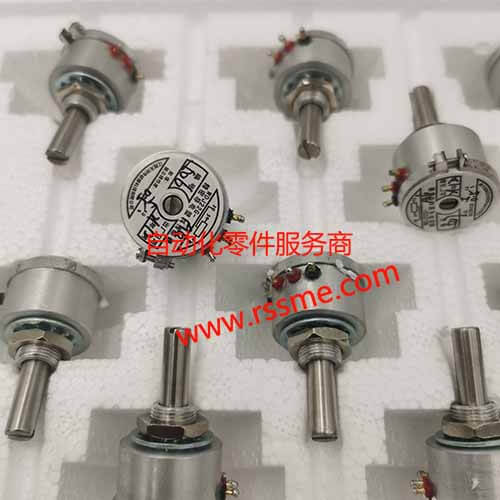WDJ22G-A6
Resistance: 5KΩ (total resistance between fixed ends).
Power: 0.5W (maximum allowable power consumption).
Size: Cylindrical metal housing with a diameter of about 22mm.
Installation: With metal sleeves and slotted metal shafts, panel holes are required for installation with fixed nuts.
Pins: Bottom axial pins (typically three leads).
Features: "Precision instrument" grade, which means high accuracy, good stability, long life, and smooth feel.
Application: Corrosion-resistant potentiometers for battery factories.
What is a potentiometer?
The most basic function of a potentiometer is a variable resistor.
It has three main terminals: two fixed terminals and one sliding contact (also called a brush) terminal.
By rotating the top shaft (knob shaft), the position of the sliding contact on the internal resistance track can be changed, thereby continuously changing the resistance value between the two ends (the total resistance between the two fixed ends is fixed, and the resistance value between the sliding end and any end point is variable).
Appearance and structure
Cylindrical metal shell. The metal shell usually provides electromagnetic shielding and a certain mechanical strength.
Key components: The shaft (knob shaft) extending from the top center. This is where the user adjusts the resistance value, and a plastic knob is usually installed for easy operation.
Pin leads: Red, black and other colored wires (pins) leading out from the side. The most common pin configuration of a potentiometer is three (corresponding to two fixed ends and one sliding end). Red and black are common identification colors, usually used to identify the positive connection of the power supply and the ground (or common end), or to distinguish functions (such as: red = signal input/high potential, black = signal output/low potential).
Label information: The surface of the component is affixed with a white label with parameters and identification printed on it.
Nominal resistance: The most important parameter, in ohms (Ω), commonly used values such as 1kΩ, 10kΩ, 100kΩ, 1MΩ, etc. This is the total resistance between two fixed endpoints.
Resistance curve/type: Such as A (logarithmic), B (linear), C (antilogarithmic), etc., which determines the relationship between the rotation angle and the change in resistance value. Most general-purpose potentiometers are linear (B type).
Tolerance: The allowable deviation from the nominal resistance value (such as ±10%, ±20%).
Rated power: The maximum power (in watts W) that the potentiometer is allowed to dissipate.
Applications
Potentiometers have extremely wide applications
Volume/tone control: Audio, radio, guitar effects, etc.
Brightness/contrast adjustment: Monitors, table lamp dimmers.
Speed adjustment: Fan controllers, power tools.
Voltage/current regulation: Power supplies, experimental circuit boards.
Position sensing (analog signal output): In some simple position feedback applications.
Signal level calibration/setting:Industrial control equipment, test instrument interior.
Sample image

Battery factory special corrosion resistant potentiometer WDJ22G-A6
历史文章
- 《SMC solenoid valve SY5120-5LZD-01 and SY5A34》
- 《SMC电磁阀SY5120-5LZD-01和SY5A34》
- 《Battery factory special corrosion resistant potentiometer WDJ22G-A6》
- 《电池厂专用耐腐蚀电位器WDJ22G-A6》
- 《SMC solenoid valve SY5120-5LZD-01 and SY5A34》
- 《SMC AFM30-02/03-A型自动排水过滤器》
- 《KEYENCE photoelectric sensor PR-MB30N3》
- 《CKD电磁阀3QRA110-M5-C2-3》
- 《SMC new genuine finger cylinder》

